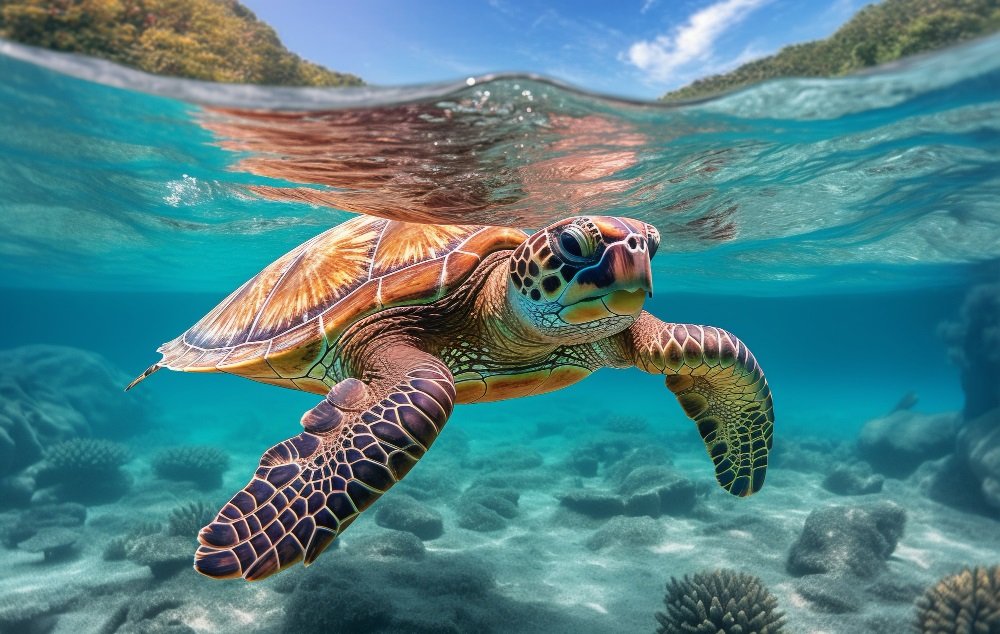Turtles are one of the most fascinating and diverse group of animals on our planet. They have been around for over 200 million years and have adapted to live in various habitats such as oceans, lakes, rivers, and even deserts. Understanding the different types of turtles is essential for conservation efforts, as many species are currently facing threats such as habitat loss, pollution, and climate change. In this article, we will explore the question, “How many types of turtles are there?” and provide an overview of the different categories and species of turtles that exist today.
The Importance of Understanding the Different Types of Turtles
Identifying the different types of turtles is important for several reasons. Firstly, it helps us understand the unique characteristics, behaviors, and habitats of each species, which is crucial for developing effective conservation strategies. Secondly, it allows us to appreciate the diversity and complexity of the natural world, and to promote awareness and education about the importance of protecting these animals and their habitats. Lastly, it can also have practical implications for human activities, such as fishing and construction, by helping us avoid harmful impacts on turtle populations.
Categories of Turtles
Turtles can be broadly categorized into two groups: chelonians and pleurodires. Chelonians, also known as cryptodires, include all turtles except for side-necked turtles. They are characterized by their ability to retract their necks straight back into their shells. Pleurodires, on the other hand, have a more flexible neck that can be tucked to the side of their bodies. This group includes side-necked turtles and soft-shelled turtles.
Chelonians
Chelonians are the largest and most diverse group of turtles, with over 230 species. They can be found on every continent except Antarctica, and include both terrestrial and aquatic species. Some examples of chelonians are:
- Sea turtles: These are large, marine turtles that are adapted to life in the ocean. They have flippers instead of legs and can travel long distances in search of food and mates.
- Tortoises: These are terrestrial turtles that live in various habitats, such as deserts, forests, and grasslands. They have stumpy, sturdy legs and a domed shell.
- Freshwater turtles: These are aquatic turtles that live in lakes, rivers, and ponds. They have webbed feet or claws and a flatter shell than tortoises.
Pleurodires
Pleurodires are a smaller group of turtles, with around 80 species. They are mostly found in the Southern Hemisphere, particularly in Australia, South America, and Africa. Some examples of pleurodires are:
- Side-necked turtles: These are freshwater turtles that have a unique way of retracting their necks to the side, rather than straight back. They are found in Australia, South America, and Africa.
- Soft-shelled turtles: These are aquatic turtles that have a leathery, flexible shell instead of a hard, bony one. They are found in North America, Africa, and Asia.
Conclusion
In conclusion, there are many types of turtles, with over 300 species distributed across the world. Understanding the different categories and species of turtles is important for conservation efforts, education, and human activities. By appreciating the unique characteristics and habitats of each species, we can promote awareness and action to protect these amazing animals and their ecosystems.
How Many Types of Turtles Are There?
Turtles are one of the most ancient and diverse group of reptiles, with over 350 species known to science. They have been around for over 200 million years and have adapted to a wide variety of habitats, from freshwater and marine environments to terrestrial ecosystems. This article will explore the different types of turtles, their characteristics, and the classification of these fascinating creatures. (See Also: What Do Sea Turtles Drink)
Classification of Turtles
Turtles belong to the order Testudines, which is further divided into two suborders: Cryptodira (hidden neck turtles) and Pleurodira (side-neck turtles). The main difference between these two suborders lies in the way they retract their necks: Cryptodira turtles pull their necks straight back into their shells, while Pleurodira turtles fold their necks to the side.
Cryptodira: Hidden Neck Turtles
Cryptodira is the largest suborder of turtles, containing approximately 75% of all turtle species. They are characterized by their ability to retract their necks directly into their shells. The following are some of the most common families of Cryptodira turtles:
- Kinosternidae: This family includes mud and musk turtles, which are small, semi-aquatic turtles found in freshwater habitats in North and Central America. They have a hinged plastron (bottom shell) that allows them to completely close their shells for protection.
- Emydidae: This family consists of pond, box, and painted turtles, which are found in freshwater and terrestrial habitats in North America, Europe, and Asia. They have a non-hinged plastron and a range of colors and patterns on their carapace (top shell) and skin.
- Testudinidae: This family encompasses tortoises, which are primarily terrestrial turtles found worldwide. They have a domed, non-hinged carapace and strong, elephant-like limbs for traversing land.
- Cheloniidae: This family is composed of sea turtles, which are marine turtles found in oceans around the world. They have a streamlined, non-hinged carapace and flippers for swimming long distances.
Pleurodira: Side-Neck Turtles
Pleurodira is the smaller suborder of turtles, containing around 25% of all turtle species. They are characterized by their ability to fold their necks to the side when retracting them into their shells. The following are some of the most common families of Pleurodira turtles:
- Chelidae: This family includes side-necked turtles, which are found in freshwater and terrestrial habitats in South America, Australia, and Africa. They have a hinged plastron and a unique, side-folding neck mechanism.
- Pelomedusidae: This family consists of mud and snapping turtles, which are found in freshwater habitats in Africa. They have a non-hinged plastron and powerful jaws for catching prey.
- Podocnemididae: This family encompasses big-headed and river turtles, which are found in freshwater habitats in South America. They have a distinctive, elongated head and a non-hinged plastron.
Freshwater Turtles
Freshwater turtles are a diverse group of turtles that live in various types of freshwater habitats, such as ponds, lakes, rivers, and wetlands. They are adapted to their aquatic environments and have several unique features that enable them to thrive in these ecosystems. Some of the common freshwater turtle families include Kinosternidae, Emydidae, Chelidae, and Pelomedusidae.
Sea Turtles
Sea turtles are a group of marine turtles that inhabit oceans around the world. They are well-adapted to their aquatic environments and have several unique features, such as a streamlined carapace and flippers for swimming long distances. The seven species of sea turtles are Cheloniidae: the green, loggerhead, hawksbill, olive ridley, and leatherback turtles, and Dermochelyidae: the leatherback turtle. (See Also: Where Do Box Turtles Live In The Wild)
Terrestrial Turtles (Tortoises)
Terrestrial turtles, or tortoises, are primarily land-dwelling turtles found worldwide. They are adapted to traversing various types of terrain, from grasslands and deserts to forests and mountains. The Testudinidae family includes some of the most well-known tortoise species, such as the Galapagos, desert, and African spurred tortoises.
Conservation Status of Turtles
Many turtle species are facing significant threats due to habitat loss, pollution, climate change, and overexploitation for the pet trade and human consumption. As a result, several turtle species are listed as endangered or vulnerable on the IUCN Red List. Conservation efforts, such as habitat restoration, captive breeding programs, and legislation protecting turtles and their habitats, are crucial for the survival of these ancient and diverse creatures.
Recap
In this article, we explored the fascinating world of turtles and the different types of turtles that exist. We learned about the two suborders of turtles, Cryptodira and Pleurodira, and their distinct neck-retraction mechanisms. We also discussed the various families of freshwater, sea, and terrestrial turtles, as well as the conservation status of many turtle species. Turtles are an essential part of our planet’s biodiversity, and it is crucial that we take action to protect and conserve these remarkable creatures for future generations.
Frequently Asked Questions about ‘How Many Types of Turtles Are There’
1. How many species of turtles are there in the world?
There are around 360 species of turtles in the world, including both freshwater and sea turtles. However, this number can vary slightly depending on the source and the classification of subspecies.
2. What are the different types of turtles based on their habitats?
Turtles can be categorized into three main groups based on their habitats: terrestrial turtles (tortoises) that live primarily on land, freshwater turtles that live in rivers, lakes, and ponds, and marine turtles (sea turtles) that live in oceans.
3. What are some examples of terrestrial turtles?
Some examples of terrestrial turtles or tortoises include the Gopher Tortoise, the Desert Tortoise, the Galapagos Tortoise, and the African Spurred Tortoise. (See Also: What’S The Name Of The Rat In Ninja Turtles)
4. What are some examples of freshwater turtles?
Some examples of freshwater turtles include the Painted Turtle, the Snapping Turtle, the Softshell Turtle, and the Map Turtle.
5. What are some examples of marine turtles?
Some examples of marine turtles or sea turtles include the Leatherback Turtle, the Green Turtle, the Loggerhead Turtle, the Hawksbill Turtle, and the Olive Ridley Turtle.


